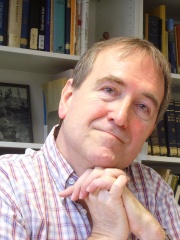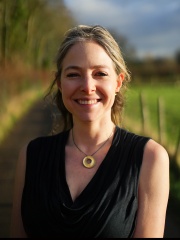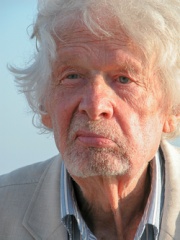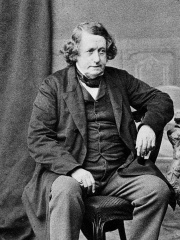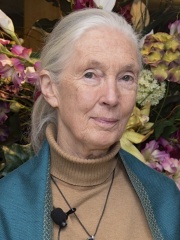
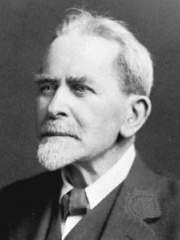
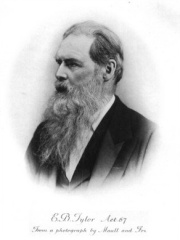
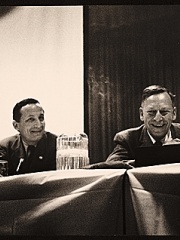
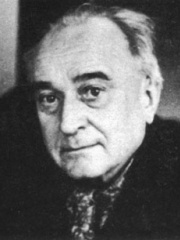
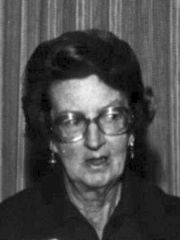


The Most Famous
ANTHROPOLOGISTS from United Kingdom
This page contains a list of the greatest British Anthropologists. The pantheon dataset contains 93 Anthropologists, 16 of which were born in United Kingdom. This makes United Kingdom the birth place of the 2nd most number of Anthropologists.
Top 10
The following people are considered by Pantheon to be the top 10 most legendary British Anthropologists of all time. This list of famous British Anthropologists is sorted by HPI (Historical Popularity Index), a metric that aggregates information on a biography's online popularity. Visit the rankings page to view the entire list of British Anthropologists.

1. Jane Goodall (1934 - 2025)
With an HPI of 75.73, Jane Goodall is the most famous British Anthropologist. Her biography has been translated into 83 different languages on wikipedia.
Dame Valerie Jane Morris Goodall (; née Morris-Goodall; 3 April 1934 – 1 October 2025) was an English primatologist and anthropologist. Regarded as a pioneer in primate ethology, and described by many publications as "the world's preeminent chimpanzee expert", she was best known for more than six decades of field research on the social and family life of wild chimpanzees in the Kasakela chimpanzee community at Gombe Stream National Park in Tanzania. Beginning in 1960, under the mentorship of the palaeontologist Louis Leakey, Goodall's research demonstrated that chimpanzees share many key traits with humans, such as using tools, having complex emotions, forming lasting social bonds, engaging in organised warfare, and passing on knowledge across generations, which redefined the traditional view that humans are uniquely different from other animals. In 1965 Goodall was awarded a PhD in ethology from the University of Cambridge. In the 1960s Goodall published several accounts of her research in Tanzania, including a series of articles in National Geographic. Her first book-length study, In the Shadow of Man (1971), was later translated into 48 languages. She founded the Jane Goodall Institute in 1977 to promote wildlife conservation, followed by the Roots & Shoots youth programme in 1991, which grew into a global network. Goodall also established wildlife sanctuaries and reforestation projects in Africa and campaigned for the ethical treatment of animals in animal testing, animal husbandry and captivity. Goodall was appointed a United Nations Messenger of Peace in 2002, and advised organisations such as Save the Chimps and the Society for the Protection of Underground Networks. Throughout her career Goodall wrote 32 books, 15 of them for children, and was the subject of over 40 films. She remained an active lecturer, travelling extensively to promote conservation and climate action. Goodall was an honorary member of the World Future Council. Among other honours, she was a recipient of the National Geographic Society's Hubbard Medal, the Kyoto Prize, the Templeton Prize and the United States Presidential Medal of Freedom. In 2003 she was named a dame commander of the Order of the British Empire by Queen Elizabeth II. Goodall served on the board of the Nonhuman Rights Project from 2022 until her death.

2. James George Frazer (1854 - 1941)
With an HPI of 74.05, James George Frazer is the 2nd most famous British Anthropologist. His biography has been translated into 51 different languages.
Sir James George Frazer (; 1 January 1854 – 7 May 1941) was a Scottish social anthropologist and folklorist influential in the early stages of the modern studies of mythology and comparative religion.

3. Edward Burnett Tylor (1832 - 1917)
With an HPI of 73.49, Edward Burnett Tylor is the 3rd most famous British Anthropologist. His biography has been translated into 49 different languages.
Sir Edward Burnett Tylor (2 October 1832 – 2 January 1917) was an English anthropologist, and professor of anthropology. Tylor's ideas typify 19th-century cultural evolutionism. In his works Primitive Culture (1871) and Anthropology (1881), he defined the context of the scientific study of anthropology, based on the evolutionary theories of Charles Lyell. He believed that there was a functional basis for the development of society and religion, which he determined was universal. Tylor maintained that all societies passed through three basic stages of development: from savagery, through barbarism to civilization. Tylor is a founding figure of the science of social anthropology, and his scholarly works helped to build the discipline of anthropology in the nineteenth century. He believed that "research into the history and prehistory of man [...] could be used as a basis for the reform of British society". Tylor reintroduced the term animism (faith in the individual soul or anima of all things and natural manifestations) into common use. He regarded animism as the first phase in the development of religions.

4. Gregory Bateson (1904 - 1980)
With an HPI of 69.56, Gregory Bateson is the 4th most famous British Anthropologist. His biography has been translated into 35 different languages.
Gregory Bateson (9 May 1904 – 4 July 1980) was an English anthropologist, social scientist, linguist, visual anthropologist, semiotician, and cyberneticist whose work intersected that of many other fields. His writings include Steps to an Ecology of Mind (1972) and Mind and Nature (1979). In Palo Alto, California, Bateson and his colleagues developed the double-bind theory of schizophrenia. Bateson's interest in systems theory forms a thread running through his work. He was one of the original members of the core group of the Macy conferences in Cybernetics (1941–1960), and the later set on Group Processes (1954–1960), where he represented the social and behavioral sciences. He was interested in the relationship of these fields to epistemology. His association with the editor and author Stewart Brand helped widen his influence.
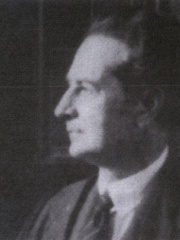
5. Alfred Radcliffe-Brown (1881 - 1955)
With an HPI of 67.56, Alfred Radcliffe-Brown is the 5th most famous British Anthropologist. His biography has been translated into 37 different languages.
Alfred Reginald Radcliffe-Brown, FBA (born Alfred Reginald Brown; 17 January 1881 – 24 October 1955) was an English social anthropologist who helped further develop the theory of structural functionalism. He conducted fieldwork in the Andaman Islands and Western Australia, which became the basis of his later books. He held academic appointments at universities in Cape Town, Sydney, Chicago, and Oxford, and sought to model the field of anthropology after the natural sciences.

6. E. E. Evans-Pritchard (1902 - 1973)
With an HPI of 65.28, E. E. Evans-Pritchard is the 6th most famous British Anthropologist. His biography has been translated into 32 different languages.
Sir Edward Evan Evans-Pritchard FBA FRAI (21 September 1902 – 11 September 1973) was an English anthropologist who was instrumental in the development of social anthropology. He was Professor of Social Anthropology at the University of Oxford from 1946 to 1970.

7. Mary Leakey (1913 - 1996)
With an HPI of 65.22, Mary Leakey is the 7th most famous British Anthropologist. Her biography has been translated into 47 different languages.
Mary Douglas Leakey, FBA (née Nicol, 6 February 1913 – 9 December 1996) was a British paleoanthropologist who discovered the first fossilised Proconsul skull, an extinct ape believed to be ancestral to humans. She also discovered the robust Zinjanthropus skull at Olduvai Gorge in Tanzania, eastern Africa. For much of her career she worked with her husband, Louis Leakey, at Olduvai Gorge, where they uncovered fossils of ancient hominines and the earliest hominins, as well as the stone tools produced by the latter group. Mary Leakey developed a system for classifying the stone tools found at Olduvai. She discovered the Laetoli footprints, and at the Laetoli site she discovered hominin fossils that were more than 3.75 million years old. During her career, Leakey discovered fifteen new species of animal. She also brought about the naming of a new genus. In 1972, after the death of her husband, Leakey became director of excavations at Olduvai. She maintained the Leakey family tradition of palaeoanthropology by training her son, Richard, in the field.

8. Victor Turner (1920 - 1983)
With an HPI of 64.56, Victor Turner is the 8th most famous British Anthropologist. His biography has been translated into 28 different languages.
Victor Witter Turner (28 May 1920 – 18 December 1983) was a British cultural anthropologist best known for his work on symbols, rituals, and rites of passage. His work, along with that of Clifford Geertz and others, is often referred to as symbolic and interpretive anthropology.

9. Edmund Leach (1910 - 1989)
With an HPI of 58.86, Edmund Leach is the 9th most famous British Anthropologist. His biography has been translated into 22 different languages.
Sir Edmund Ronald Leach (7 November 1910 – 6 January 1989) was a British social anthropologist and academic. He served as provost of King's College, Cambridge from 1966 to 1979. He was also president of the Royal Anthropological Institute from 1971 to 1975.
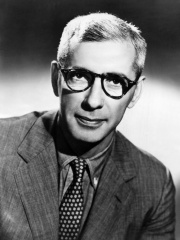
10. Ashley Montagu (1905 - 1999)
With an HPI of 56.23, Ashley Montagu is the 10th most famous British Anthropologist. His biography has been translated into 20 different languages.
Montague Francis Ashley-Montagu (born Israel Ehrenberg; June 28, 1905 – November 26, 1999) was a British-American anthropologist who popularized the study of topics such as race and gender and their relation to politics and development. He was the rapporteur, in 1950, for the UNESCO "statement on race". As a young man he changed his name from Ehrenberg to "Montague Francis Ashley-Montagu". After relocating to the United States he used the name "Ashley Montagu". Montagu, who became a naturalized American citizen in 1940, taught and lectured at Harvard, Princeton, Rutgers, the University of California, Santa Barbara, and New York University. Forced out of his Rutgers position after the McCarthy hearings, he repositioned himself as a public intellectual in the 1950s and 1960s, appearing regularly on television shows and writing for magazines and newspapers. He authored over 60 books throughout this lifetime. In 1995, the American Humanist Association named him the Humanist of the Year.
People
Pantheon has 16 people classified as British anthropologists born between 1808 and 1973. Of these 16, 3 (18.75%) of them are still alive today. The most famous living British anthropologists include Marilyn Strathern, Chris Stringer, and Alice Roberts. The most famous deceased British anthropologists include Jane Goodall, James George Frazer, and Edward Burnett Tylor.
Living British Anthropologists
Go to all RankingsMarilyn Strathern
1941 - Present
HPI: 53.73
Chris Stringer
1947 - Present
HPI: 48.97
Alice Roberts
1973 - Present
HPI: 38.15
Deceased British Anthropologists
Go to all RankingsJane Goodall
1934 - 2025
HPI: 75.73
James George Frazer
1854 - 1941
HPI: 74.05
Edward Burnett Tylor
1832 - 1917
HPI: 73.49
Gregory Bateson
1904 - 1980
HPI: 69.56
Alfred Radcliffe-Brown
1881 - 1955
HPI: 67.56
E. E. Evans-Pritchard
1902 - 1973
HPI: 65.28
Mary Leakey
1913 - 1996
HPI: 65.22
Victor Turner
1920 - 1983
HPI: 64.56
Edmund Leach
1910 - 1989
HPI: 58.86
Ashley Montagu
1905 - 1999
HPI: 56.23
Jack Goody
1919 - 2015
HPI: 56.11
Hugh Falconer
1808 - 1865
HPI: 55.46
Overlapping Lives
Which Anthropologists were alive at the same time? This visualization shows the lifespans of the 13 most globally memorable Anthropologists since 1700.


